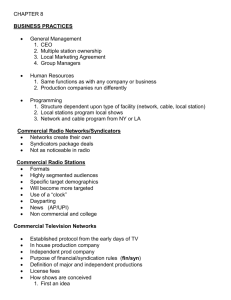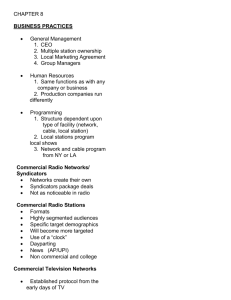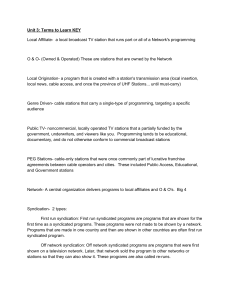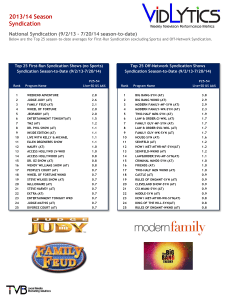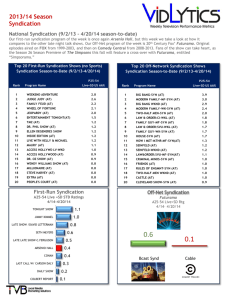Chapter 5 – Television
advertisement
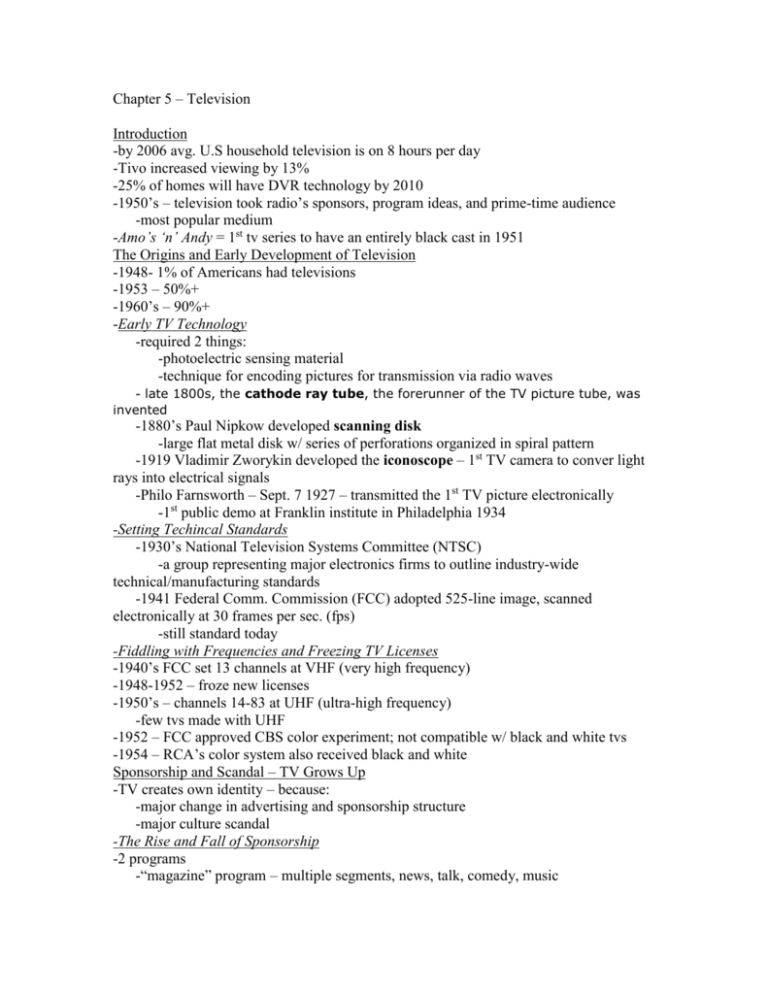
Chapter 5 – Television Introduction -by 2006 avg. U.S household television is on 8 hours per day -Tivo increased viewing by 13% -25% of homes will have DVR technology by 2010 -1950’s – television took radio’s sponsors, program ideas, and prime-time audience -most popular medium -Amo’s ‘n’ Andy = 1st tv series to have an entirely black cast in 1951 The Origins and Early Development of Television -1948- 1% of Americans had televisions -1953 – 50%+ -1960’s – 90%+ -Early TV Technology -required 2 things: -photoelectric sensing material -technique for encoding pictures for transmission via radio waves - late 1800s, the cathode ray tube, the forerunner of the TV picture tube, was invented -1880’s Paul Nipkow developed scanning disk -large flat metal disk w/ series of perforations organized in spiral pattern -1919 Vladimir Zworykin developed the iconoscope – 1st TV camera to conver light rays into electrical signals -Philo Farnsworth – Sept. 7 1927 – transmitted the 1st TV picture electronically -1st public demo at Franklin institute in Philadelphia 1934 -Setting Techincal Standards -1930’s National Television Systems Committee (NTSC) -a group representing major electronics firms to outline industry-wide technical/manufacturing standards -1941 Federal Comm. Commission (FCC) adopted 525-line image, scanned electronically at 30 frames per sec. (fps) -still standard today -Fiddling with Frequencies and Freezing TV Licenses -1940’s FCC set 13 channels at VHF (very high frequency) -1948-1952 – froze new licenses -1950’s – channels 14-83 at UHF (ultra-high frequency) -few tvs made with UHF -1952 – FCC approved CBS color experiment; not compatible w/ black and white tvs -1954 – RCA’s color system also received black and white Sponsorship and Scandal – TV Grows Up -TV creates own identity – because: -major change in advertising and sponsorship structure -major culture scandal -The Rise and Fall of Sponsorship -2 programs -“magazine” program – multiple segments, news, talk, comedy, music -NBC introduced Today Show – 3 hour morning program; Tonight Show – 90 mins -television special -The Quiz-Show Scandals seal Sponsorship’s Fate -cheap to produce -pressure to rig shows put end to sponsors -mistrust led parents to refusing to allow their children to watch television -magnified separation between privileged few and general public Major Programming Trends in the TV Age -TV Information: Our Daily News Culture -NBC News -Meet the Press (1947-) oldest show on television -CBS News -affiliate stations: independently owned stations that sign contracts with a network and carry its programs -Walter Cronkite anchored the first 30 minute network newscast (1963) -ABC News -Barbara Walters = 1st woman to regularly coanchor a network newscast -Contemporary Trends in Network and Cable News -MSNBC = 1st news channel available simultaneously on cable and the web -TV Entertainment: Our Comic and Dramatic Culture -kinescope: way to preserve live broadcast; film camera recorded a live TV show off a studio monitor -sketch comedy: vaudeo; marriage of vaudeville and video -situation comedy: half-hour comedy series; only genre represented in the Top 10 rated programs EVERY year between 1949-2006 -domestic comedy: spin-off of sitcom, characters and settings are more important than complicated predicaments -anthology drama: brought dramatic theater to television -fell apart 4 reasons: -advertisers did not like -watched by those who could already afford tickets to the theater -too expensive to produce -dealt with social issues that were controversial -episodic series: characters continue week to week and sets remain the same; 2 types -chapter shows: self contained – problem, conflict, resolution -serial programs: open-ended, story continues through episodes The Decline of the Network Era - network era: the period from the late 1950s, when the networks gained control over TV’s content, to the end of the 1970s - three factors cause the decline of the network era: technological changes, government regulations, development of new networks - New Technologies Reduce Network Control - two major developments: arrival of communication satellite services for cable television and the home video market - growth of cable springs loose in 1972 - 1975: HBO becomes available to individual cable markets - independent station: not affiliated with a network - December 1976: Ted Turner beamed signal from WTBS to a satellite where cable systems and stations around the country could access it, initially free - in the mid-1970s, only about 15% of households received cable - early 2000s, about 70% - videocassette recorders (VCRs): came in 1975-76, enabled viewers to tape-record TV programs and play them back later on TV - in 1975, Sony introduced a home version of the VCR, called Betamax (Beta for short) - in 1976, JVC in Japan introduced VHS (Video Home System), helped to drive down cost of VCRS by creating marketing way - today, DVD format has replaced VHS - time shifting: occurs when viewers tape shows and watch them later, when it is more convenient - time shifting makes it possible to avoid ads all-together - DVRs (digital video recorders): enabled users to find and record specific shows onto the computer memory of the DVR, as opposed to storage on bulky tapes - Government Regulations Temporarily Restrict Network Control - Prime Time Access Rule (PTAR) in April 1970, took the 7:30 to 8:00 p.m. slot away from networks and gave it to local stations in the nation’s fifty largest TV markets - infotainment: programs that packaged human-interest and celebrity stories in TV news style, during which local affiliates sold lucrative regional ads - examples: Entertainment Tonight - fin-syn: Financial Interest and Syndication Rules, created in 1970 by the FCC, “most damaging attack against network TV monopoly in FCC history”, banned networks from reaping profits from program syndication - Department of Justice in 1975, limited networks’ own production of non-news shows to a few hours a week; ABC, CBS, NBC limited to eight hours per-week of inhouse entertainment programs outside prime time - 1990s, FCC gradually phased out the ban limiting network production - in 1995, networks again allowed to syndicate and profit from rerun programs - Emerging Networks Target the Youth Market - Murdoch launched Fox in April 1987, began targeting both young and black audiences with shows like The Simpsons, Beverly Hills 90210, In Living Color, Melrose Place, etc. - Paramount and Time Warner launched UPN and the WB in 1995, targeted young viewers with shows such as Moesha, Buffy the Vampire Slayer, Dawson’s Creek, Gilmore Girls, etc. - by 2005-06, not one UPN or WB show ranked among the top 100 programs according to audience ratings, so CBS and Time Warner merged the network into onecalled the CW The Economics of Television - Prime- Time Production - production costs in TV fall into two categories: (1) below-the-line, account for 40% of a new program’s production budget, include the technical side of production like special effects, cameras and crews, sets and designers, etc. and (2) above-the-line, include creative talent like actors, writers, producers, editors, and directors - Risky Business: Deficit Financing and the Independents - deficit financing: means that the production company leases the show to a network for a license fee that is actually less than the cost of production - networks finance the deficit and hope to make profit on syndicated shows such as Friends, Seinfield, etc. - rerun syndication: programs that stay in a network’s lineup long enough to build up sufficient episodes are sold, or syndicated, to hundreds of TV stations in the U.S. and overseas - Network Cost-Saving Strategies - shows like American Idol and Dateline require less outlay demanded by an hour’s worth of drama - producing projects in-house saves the cost of license fees to independent producers - Prime- Time Distribution - by 2006, ABC, CBS, NBC, Fox, and CW each allied with 200 to 250 stations - pay a fee to affiliate stations in return for selling ad. time - O and O’s: network-owned-and-operated stations - clearance rules: established in the 1940s by the Justice Department and the FCC, all local affiliates are ultimately responsible for the content of their channels and must clear, or approve, all network programming - Syndication Keeps Shows Going and Going… - evergreens: popular old network reruns such as the Andy Griffith Show or I Love Lucy - networks usually select and distribute about three hours of programming each nigh during prime time, and another three to four hours of daytime programming, but this leaves many hours to fill - it’s cheaper to buy syndicated programs than to produce local programs - Off-Network and First-Run Syndication - fringe time: includes programming immediately before the evening’s prime-time schedule, called early fringe, and the time following the local evening news or the network’s late-night talk shows, called late fringe - off-network syndication: older programs, no longer running during network prime time, are made for reruns to local stations, cable operators, online services, and foreign markets - example: station may buy old Cosby Show, Simpsons, Everybody Loves Raymond to boost its ratings before and after news - first-run syndication: any program that is specifically produced for sale into syndication markets - example: Wheel of Fortune, Oprah made for syndication - Barter vs. Cash Deals - cash deal: distributor of a program offers a series for syndication to the highest bidder in a market - cash-plus: distributors may retain some time to sell national commercial spots, keep down the cost per episode - barter deals: usually arranged for new, untested programs or older programs, no money changes hands between the local station and the syndicator, syndicator offers a program to a local TV station in exchange for a split of the advertising revenue - Measuring Television by Ratings and Shares - rating: a statistical estimate expressed as a percentage of households tuned to a program in the local or national market being sampled - share: a statistical estimate of the percentage of homes tuned to a program compared with those actually using their sets at the time of a sample - audience members tell advertisers how many people are watching, and what kind of people are watching - Alternative Voices - Paper Tiger Television (PTTV): a group of about 100 producers, activists, artists, technicians, scholar, etc. who have created 320 programs since 1981 The Public, Television, and Democracy - development of cable, VCR and DVD, new networks, DVRs, iPods, and Internet services fragment us by appealing to out individual and special needs

